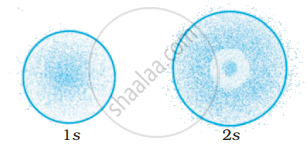Advertisements
Advertisements
प्रश्न
The pair of ions having same electronic configuration is ______.
विकल्प
\[\ce{Cr^{3+}, Fe^{3+}}\]
\[\ce{Fe^{3+}, Mn^{2+}}\]
\[\ce{Fe^{3+}, Co^{3+}}\]
\[\ce{Sc^{3+}, Cr^{3+}}\]
उत्तर
The pair of ions having same electronic configuration is \[\ce{Fe^{3+}, Mn^{2+}}\].
Explanation:
\[\ce{Fe^{3+}}\] electronic configuration is 1s2 2s2 2p6 3s2 3p6 3d5 4s2
\[\ce{Mn^{2+}}\] electronic configuration is 1s2 2s2 2p6 3s2 3p6 3d5 4s2
APPEARS IN
संबंधित प्रश्न
State Heisenberg uncertainty principle.
Define the term Electronic configuration
Write a note on ‘Principal Quantum number.
The designation of a subshell with n = 6 and l = 2 is ____________.
Which one of the following orders is CORRECT in case of energy of the given subshells?
P: n = 4; l = 3
Q: n = 5; I = 1
R: n = 5; l = 0
S: n = 4; l = 2
How many electrons can fit in the orbital for which n = 4 and l = 2?
The probability density plots of 1s and 2s orbitals are given in Figure:

The density of dots in a region represents the probability density of finding electrons in the region.
On the basis of above diagram which of the following statements is incorrect?
Which of the following sets of quantum numbers are correct?
| `n` | `l` | `m_l` | |
| (i) | 1 | 1 | +2 |
| (ii) | 2 | 1 | +1 |
| (iii) | 3 | 2 | –2 |
| (iv) | 3 | 4 | –2 |
The arrangement of orbitals on the basis of energy is based upon their (n + l) value. Lower the value of (n + l), lower is the energy. For orbitals having same values of (n + l), the orbital with lower value of n will have lower energy.
Based upon the above information, solve the questions given below:
Which of the following orbitals has the lowest energy?
4d, 4f, 5s, 5p
Which of the following element do not follow Aufbau principle?
